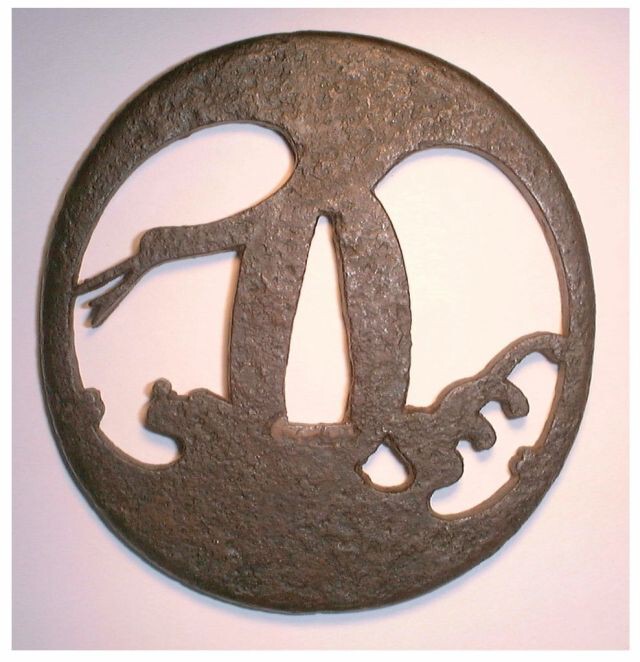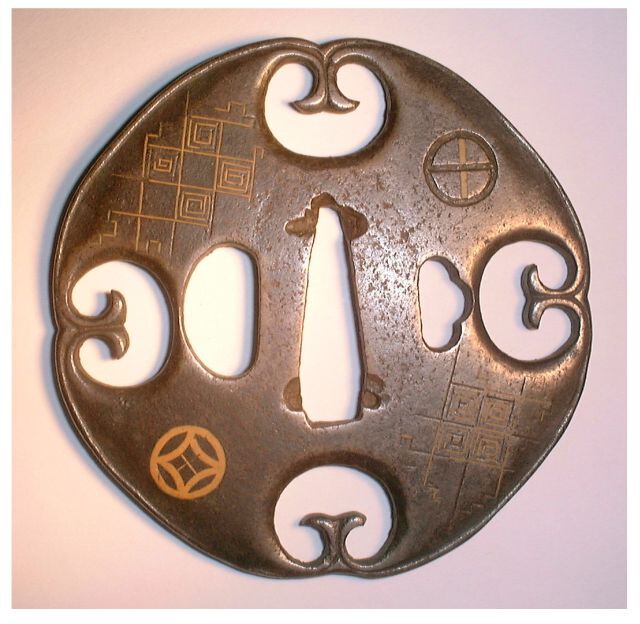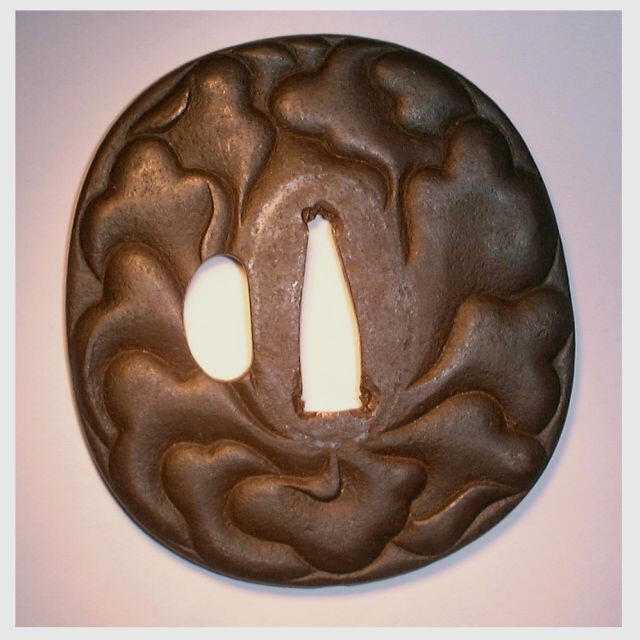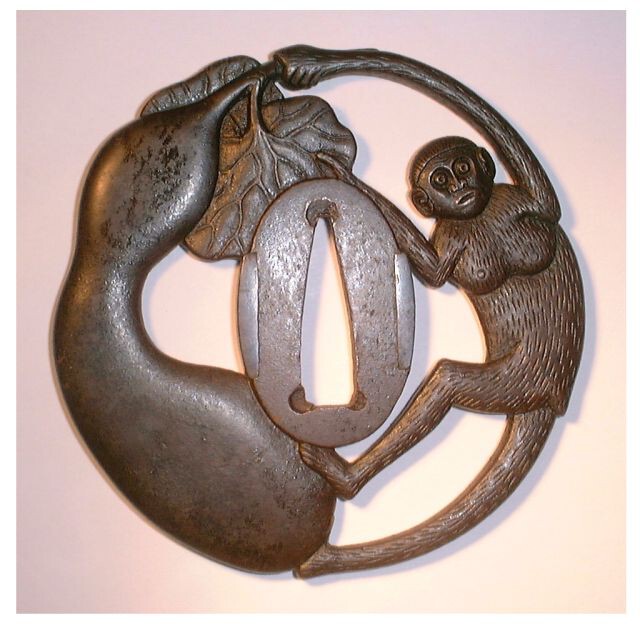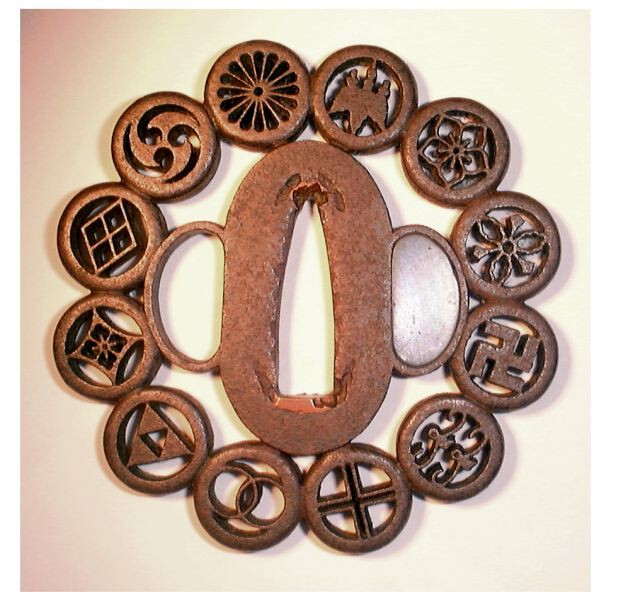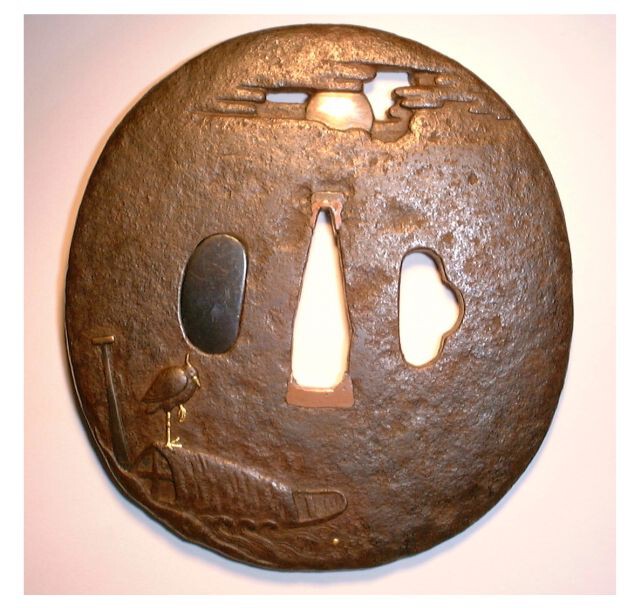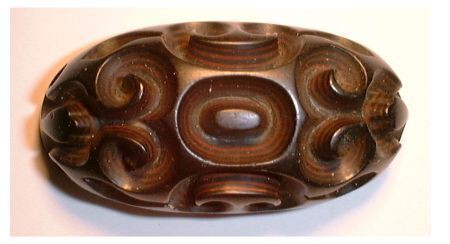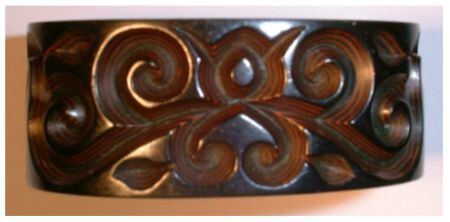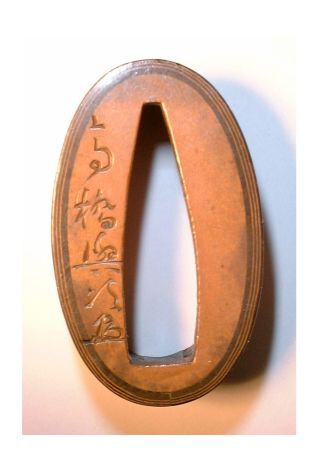-
Posts
815 -
Joined
-
Last visited
-
Days Won
1
Content Type
Profiles
Forums
Events
Store
Downloads
Gallery
Everything posted by docliss
-
Thank you for that, Curran. Is the reference that you are seeking #626 in the Oeder catalogue? This is very similar in design, although much more 'Odaesque', with its delicate stem execution. John L.
-
Dear Brian Thank you for the recent ‘bump to the top’. I am interested that you, like an earlier member, suggest a Choshu attribution for tsuba F, and presume to suggest that this might be prompted by its black patination — a common feature of Choshu tsuba. But I question this attribution for a number of reasons: While Choshu tsuba are frequently of a black colour, they are not polished, as is this one. They are commonly ubu-sukashi designs in which plants or human figures predominate; true marubori, as in this tsuba, is uncommon. And these designs are much more delicate than the rather crude image of tsuba F. They are usually maru-gata or tate-maru-gata, with a solid mimi: irregular shapes, such as this one, are seldom seen. They commonly have gold nunome decoration, whereas this tsuba is devoid of any decoration. They are frequently inscribed ‘Choshu (no)ju’ followed by the maker’s name — this one is mumei. I personally wonder if tsuba F is a late C17 Oda tsuba, but suspect that your suggestion that these three tsuba are beneath the interest of our more knowledgeable and specialised members may, sadly, be correct. Regards, John L.
-
Dear Scott I am sure that you are correct and that the object in question is a gourd rather than a daikon. Thank you. John L.
-
Among all off you members 'out there' is there not one of you prepared to offer an attribution for tsuba E and F? John L.
-
Dear Richard I have, in my collection, a tsuba very like your own apart from some small details, and the fact that it lacks the openings in its lower segment. Measuring 7.1 cm – 6.8 cm, I have it catalogued as mumei and as early Akasaka work. But, with the wisdom of hindsight, I suspect that it has traces of a mei, although these have not come out in my photograph. You are doubtless aware of another similar tsuba, #2 on pl. XVII of Hamilton’s rather flawed catalogue of the Peabody Museum’s collection. All three tsuba appear to vary only in the presence or absence of a mei and in the distribution of the lower hitsu. Regards, John L.
-
With my grateful thanks to Curran and to Pete Klein for their help with my previous enquiry, I am encouraged to attach a further three iron tsuba in a search for more information. Tsuba D Rendered in a polished iron, and of a modified mokko-gata, this tsuba is slightly lenticular in profile and has a delicately raised rim. It measures 7.4 cm – 7.4 cm and, at its four poles, has circular apertures featuring bracken shoots. There are pale brass hira-zogan designs on both surfaces (or are they of sentoku?) comprising kutsuwa and simplified shippo mon, and a diaper design; sadly, some of the inlay is missing. The nakago-hitsu is much altered and, of the two ryo-hitsu, that for the kogai is remarkably small. Heianjo-zogan work certainly, but is the tiny kogai-hitsu of any help in a more detailed attribution? Tsuba E This is a darkly patinated iron guard measuring 8.0 cm – 7.3 cm. Both surfaces are covered with a low relief engraving of peony petals. The seppa-dai is slightly raised, and there is a single kodzuka-hitsu. Tsuba #187 in the Naunton catalogue, illustrated on pl. XVI, is not dissimilar, and bears a shumei for Umetade Miojiu (sic). But I suspect that this may be yet another Shoami piece. Tsuba F An openwork tsuba in a black, polished iron, this measures 7.5 cm – 7.5 cm. The left-hand side is formed by a daikon and its leaf while, on the right-hand side, is a monkey, its hind leg and tail resting on the root while its left arm extends to hold the stem. The animal has kebori fur, both ryo-hitsu have shakudo sekigane, and there are remnants of black lacquer on the daikon. With grateful thanks, John L.
-
Dear Michel You are quite correct in your assertion that most tsuba bear the mei on the omote side. But I am sure this was purely a convention and that, like most conventions, it could be varied at the artist’s whim. Regards, John L.
-
As a predominantly ‘kinko man’, I have in my collection a number of iron tsuba about which I should value some advice regarding their attribution from the ‘iron men’ out there. If this request is well-received, perhaps I may repeat it in the future? Tsuba A This is a large, heavy, openwork guard in a darkly patinated iron. It measures 8.2 cm – 8.2 cm, has a solid and slightly rounded rim, and the design within this incorporates four pairs of linked bracken shoots. Above and below are pawlonia mon of the 3:3:3 form, with gold veining on the leaves and solid gold overlay on the blossoms. Laterally there are pine-bark (triple diamond) mon. A similar, but earlier, guard is illustrated on p. 62 of Sasano’s ‘Early Japanese Sword Guards: Sukashi Tsuba’. Here it is labelled as Kyo-Sukashi work, but at what stage did such work incorporate gold decoration? Tsuba B This is another heavy, openwork guard in an almost black iron, measuring 7.5 cm – 7.5 cm. Within a solid and slightly rounded rim which contains linear tokketsu, are depicted, above and below, two straw hats and, on either side, two snow flakes. The straw hats have kebori detail upon them and the snow flakes, with raised rims and textured surfaces, enclose two, broad ryo-hitsu. The nakago-hitsu is much worn, and contains several generations of sekigane. The broad ryo-hitsu cause me to wonder if this is early Kyo-Shoami work? Tsuba C Measuring 7.0 cm – 7.0 cm, this is a beautiful example of mon-sukashi work, modelled in a rich, dark iron. Twelve easily identifiable mon, each rendered in a positive silhouette within solid rims, form a continuous ring surrounding the seppa-dai. There are two hangetsu-gata ryo-hitsu, one with shakudo umagane. Copper sekigane are present in the nakago-hitsu, and there are possible tagane-mei on the seppa-dai. This tsuba is ex the Peak and Behrens collections. Mon-sukashi work, certainly, but please tell me more. With thanks for your help, John L.
-
The recent, authoritative article on Kaneie tsuba by Richard Turner, in the October edition of his tosogu.com, has prompted me to seek opinions on the attached tsuba from my collection. This is of a darkly patinated, and beautifully textured iron. Tate-maru-gata, measuring 8.0 cm – 7.4 cm, it is slightly lenticular in cross-section, and depicts a silver moon, shining through openwork clouds. On the obverse, a cormorant, with golden legs, beak and eye is perched upon the prow of a boat while, on the reverse, is a cormorant fisherman, depicted in an iroye of shakudo, silver and gold. Water and reeds are carved out of the iron ground. The kodzuka-hitsu has shakudo umagane and the guard bears the inscription ‘YAMASHIRO KUNI FUSHIMI (NO)JU KANEIE. It is interesting to observe that the dominant image appears, unusually, on the ura surface of this tsuba. This, surely, is not Kaneie work; is it, I wonder, Ko-Nara in its origin? Regards, John L.
-
You may well be right about it being removable - I note that there is one, also, on the kashira. Perhaps Robert can clarify if this is so? John L.
-
We are all agreed, it seems, that the fuchi-gashira on Robert’s wakizashi are guri-bori and the tsuba Nagoya-mono. I love the gold, rope-like rims on the former, and this is an unusual feature on such work. Robert has not illustrated the tenjo of the fuchi, and I therefore assume that the set is unsigned. The mismatching of the fittings on this sword does not surprise me at all. Tsuba are constantly being swapped around by collectors but, fortunately, fuchi-gashira and menuki are much more difficult to remove, and are thus more frequently original. One can be certain that whoever was responsible for this swap got a better tsuba in exchange! I have attached photographs of a guri-bori fuchi-gashira from my own collection. The Takahashi family were the predominant workers in this technique, and this set bears the signature and kao of Takahashi Okitsugu (H 07479.0). This artist was the son of Takahashi Masatsugu, the founder of the school, and worked in Edo ca 1775-1800. Ref. Haynes’ Index of Japanese Sword Fittings and Associated Artists, p. 1461. Kinko Meikan, p. 60a. Regards, John L.
-
Are any of you able to advise me how important is the presence of shitodome in the kashira when submitting fuchi-gashira for shinsa? Also, would modern shitodome be considered as a fault in these circumstances? With many thanks, John L.
-
I agree Mikolaj, a lovely collection of typically Soten tsuba. Interestingly, the seventeenth example down is very similar to the first of the ones that I posted above; the mei also is very similar. I must also comment adversely on their method of display; several of the tsuba appear to be suspended by a thin wire, which is already marking them. Regards, John L.
-
Dear Dirk The artefact that you have so beautifully illustrated is clearly intended to function as an umabari rather than as a ko-gatana and should, in my opinion, be labelled as such. It is true than umabari were generally constructed in one piece, and one can surmise indefinitely as to whether the artist decided, for some reason, to make it this way or, as I prefer, an umabari blade was made specifically to insert into a pre-existing ko-gatana handle. Be this as it may, if the handle existed on its own it would certainly then be labelled as an, albeit rather unusual, kodzuka. Regards, John L.
-
... but if your shibeyama enthusiast removed the central spines in order to simplify his job, you would end up with an image identical to the wisteria one.
-
We may have to agree to differ on this, I fear. There is a gradual reduction in the size of the openings from right to left, such as one sees in depictions of wisteria blossom. But I agree to agree regarding the nature of the work. The iron plate is, surely, katchushi work, and the shibeyama a later addition. But it may well be that the sukashi work, also, is a later modification to the original plate? Regards, John L.
-
Interesting, yes. But is that a millipede; chidori as suggested by Ford; or a wisteria blossom? Regards, John L.
-
I agree with Brian, and see the texturing on the back as representing the rock walls of a cave. Finally, as always, it is up to a personal interpretation, but I find it difficult to reconcile button mushrooms with the kawahori theme, seen as an image of good fortune, or prosperity. Regards, John L.
-
In reply to Stephen's message(s), and in the knowledge that many of you may already know this, the delightful pair of tsuba is the work of Hamano Naotoshi (H 06821.0). This artist was a student of Hamano Naoyuki, and was working in Edo ca 1850. Ref. Haynes' Index of Japanese Sword Fittings and Associated Artists, p. 1348. Shosankenshu, p. 74, no 164. Kinko Meikan,. p. 303a-b. Bauer catalogue, # 416. Regards, John L.
-
I am attaching to this e-mail, images of a rather more typical example, from my own collection, of good Soten work. In shakudo Hikone-bori, it depicts the legend of the Seven Sages in the Bamboo Grove. Compare Inami Tomihike (1969), Doitsu Kara Kaette Kita Tsuba: The Dr W Fahrenhorst Collection, pp. 64-65. Additionally, I have posted images of a shakudo Hikone-bori tsuba by an artist named Masahide (H 04013.0) in order to demonstrate the extremely high quality of workmanship achieved by artists whose work might be dismissed by some collectors as ‘not genuine Soten work’. Regards, John L.
-
Dear Mikolaj In your e-mail you ask is this tsuba genuine Soten?, and the answer to this question depends upon what you mean by genuine Soten. Work by the two Soten masters, Kitagawa Soten I and II, is extremely rare and this your tsuba is certainly not. The quality of work is sadly lacking and the mei (Soheishi Soten ?saku) is quite unlike any illustrated in the literature. If, however, you mean in the Soten style, yes it is. But the vast majority of such work is by innumerable members of the Soten school, many of whom signed their work with the name Soten, or by members of the Aizu-Shoami school, who made copies of this Hikone-bori type well into the C19. Many of these latter were sold to foreigners at the docks in Yokohama. The tsuba you illustrate is, I am sure, an example of such Aizu-Shoami work, and I would not personally waste my money on sending it to a shinsa. Regards, John L.
-
I agree with you all. It is beautiful work; the shakudo is lovely and the quality of the nanako is top class. Could this, I wonder, be Goto Ichijo school work? Regards, John L.
-
I agree with you all. It is beautiful work; the shakudo is lovely and the quality of the nanako is top class. Could this, I wonder, be Goto Ichijo school work? Regards, John L.
-
Dear Jean Very little research has been done regarding the size of tsuba for Japanese swords. Gunsaulus was one of the first when, in a footnote on p. 33 of her Japanese Sword-Mounts in the Collection of Field Museum, she stated that ‘an average size for katana tsuba is 7.5 X 8 cm: for wakizashi tsuba 6.2 X 6.6 cm; for tanto tsuba 4.5 X 6 cm’. These figures are open to serious criticism however, and my own publication, The Namban Group of Japanese Sword Guards; a Reappraisal, has on pp. 27-38 some further work on these figures. In summary, I believe that one can say that the size of tsuba depends upon a number of factors, which include the size of the sword upon which it is mounted; the current fashion of the school and period in which it was made; and finally, the personal preference of the wearer. The only dogmatic statement that can be made is that ‘katana tsuba were bigger than wakizashi tsuba were bigger than tanto tsuba’. Clearly, a lot more work needs to be done on this subject. Regards, John L.
-
Dear Doug If I might be permitted to join in on this topic, I believe that your tsuba demonstrates only a minimal Soten influence. This is the silver and copper faces of the two figures and, to judge by your photographs, these do not show the high cheek-bones that are characteristic of this group. Neither does it demonstrate the 'busyness' that is usually a feature of Soten work. I think that your tsuba is probably an example of the work of decreasing quality that came from the Aizu-Shoami school well into the C19. Your tsuba is surely no earlier than C19. Regards, John L.



